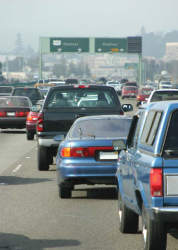
Air Pollution
What is air pollution?

Air pollution is comprised of a number of harmful substances that can be found in the air. While some types of air pollution come from nature, most are man-made. When air pollution levels rise, it can cause a serious threat to both your health and the environment. The two most common forms of air pollution include:
Ozone, also known as smog, forms when hydrocarbons and nitrogen oxides react with sunlight. Ozone is not released directly into the air - cars, factories and power plants produce chemicals that can create ozone. Ozone can also form more easily in hot weather. At ground level, ozone can pose a very serious danger to your health.
Particulate matter consists of tiny microscopic particles and liquid droplets which are more than seven times smaller than the width of a single human hair, so small that they can travel deep into your lungs and cause a number of health problems. Particulate matter comes from diesel trucks and cars, construction equipment, power plants, refineries, factories and wood smoke.
Other types of air pollution that are regulated by the government include:
- Carbon Monoxide - a poisonous gas
- Nitrogen Oxide - a gas that can create ozone
- Sulfur Dioxide - a gas released from coal-burning plants
- Lead - another deadly pollutant
Air monitoring shows that over 90 percent of Californians breathe unhealthy levels of one or more air pollutants during some part of the year.
Source: California Air Resources Board
Is air pollution still a problem?
Since the federal Clean Air Act was passed in 1970, California’s air quality has steadily improved! Over the past 25 years, the state has achieved:
- A 30% decrease in ground level ozone
- 35 times less lead pollution
- 4 times less sulfur dioxide pollution
What kind of health problems can air pollution cause?
Humans breathe in about 2,000 gallons of air each day so it is no wonder that air pollution can have negative health effects! While they may vary depending on the type of pollution, there are many common, and sometimes deadly, health problems caused by air pollution.
Breathing in polluted air can have immediate effects, including: coughing, wheezing, shortness of breath, and irritation of the eyes, nose and throat. More seriously, spikes in air pollution levels can trigger chest pain, lung infections, asthma attacks, strokes and heart attacks. Being around air pollution for a long time can be even more harmful, raising the risk for many serious diseases, including lung cancer, heart disease and asthma.
Am I at risk for health problems from air pollution?
While air pollution can hurt all individuals, certain people have a high risk:
- People with lung disease, such as asthma emphysema or Chronic Obstructive Pulmonary Disease (COPD)
- People suffering from heart disease, diabetes or other serious illnesses
- Children and babies
- Seniors
- Those who live or work near high levels of air pollution, including freeways, ports and industry
How can air pollution affect the environment?
In addition to causing health problems, air pollution has a great impact on the environment. This includes decreased visibility, acid rain as well as damage to animals, crops, plants and many other natural resources.
Air pollution can also cause global warming. Global warming refers to the rise in temperatures around the world that are leading to the melting of the polar ice caps, the rising of sea levels and changes in wind patterns. This can pose a number of problems including an increase in the number of hurricanes, tornados, droughts, floods and other climate-related disasters. Experts believe the threat of global warming is so great, that it could lead to the extinction of thousands of species, including humans.
What can I do to help fight air pollution?
There are many things you can do to help reduce air pollution!
Drive less. In California, transportation is the #1 source or air pollution. Combine trips, bike, walk, carpool or use public transit. Make your next car purchase a fuel-efficient hybrid car.
Don’t burn wood. In many parts of California, wood smoke is one of the largest sources of particulate pollution during the winter. Change your wood burning fireplace or stove to natural gas or avoid burning wood altogether.
Gas up your car at night. Gasoline evaporates when you fill up and these emissions can create ozone. At night, there is not enough sunlight to create ozone.
Report smoking cars, idling trucks or other illegal sources of air pollution to your local air quality district.
Get involved. Help Breathe California promote the use of clean fuel, toughen air quality standards and reduce existing sources of pollution. Contact your local office by calling 1-877-3-BREATHE.